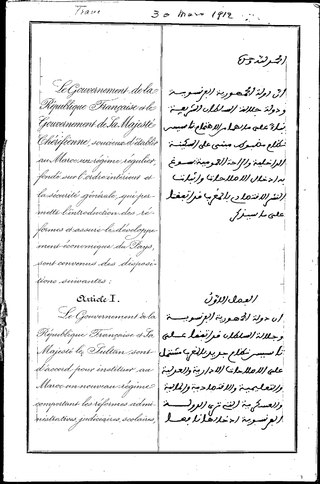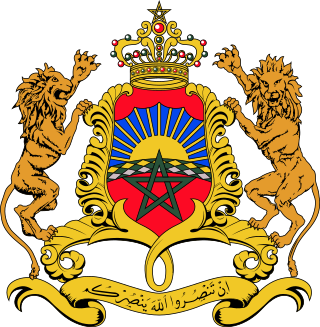
Casablanca, also known by its Arabic name Dar el-Beida, is the largest city in Morocco and the country's economic and business center. Located on the Atlantic coast of the Chaouia plain in the central-western part of Morocco, the city has a population of about 3.71 million in the urban area, and over 4.27 million in the Greater Casablanca, making it the most populous city in the Maghreb region, and the eighth-largest in the Arab world.
The history of human habitation in Morocco spans since the Lower Paleolithic, with the earliest known being Jebel Irhoud. Much later Morocco was part of Iberomaurusian culture, including Taforalt. It dates from the establishment of Mauretania and other ancient Berber kingdoms, to the establishment of the Moroccan state by the Idrisid dynasty followed by other Islamic dynasties, through to the colonial and independence periods.

The Maghreb, also known as the Arab Maghreb and Northwest Africa, is the western part of the Arab world. The region comprises western and central North Africa, including Algeria, Libya, Mauritania, Morocco, and Tunisia. The Maghreb also includes the disputed territory of Western Sahara and the Spanish cities Ceuta and Melilla. As of 2018, the region had a population of over 100 million people.

Tétouan, also known as Tettawen, is a city in northern Morocco. It lies along the Martil Valley and is one of the two major ports of Morocco on the Mediterranean Sea, a few miles south of the Strait of Gibraltar, and about 60 kilometres (37 mi) E.S.E. of Tangier. In the 2014 Moroccan census, the city recorded a population of 380,787 inhabitants. It is part of the administrative division Tanger-Tetouan-Al Hoceima.

The Banu Hilal was a confederation of Arab tribes from the Najd region of the central Arabian Peninsula that emigrated to the Maghreb region of North Africa in the 11th century. Masters of the vast plateaux of the Najd, they enjoyed a somewhat infamous reputation, possibly owing to their relatively late conversion to Islam and accounts of their campaigns in the borderlands between Iraq and Syria. When the Fatimid Caliphate became the rulers of Egypt and the founders of Cairo in 969, they hastened to confine the unruly Bedouin in the south before sending them to Central North Africa and then to Morocco.

The French protectorate in Morocco, also known as French Morocco, was the period of French colonial rule in Morocco between 1912 and 1956. The protectorate was officially established 30 March 1912, when Sultan Abd al-Hafid signed the Treaty of Fez, though the French military occupation of Morocco had begun with the invasion of Oujda and the bombardment of Casablanca in 1907.

Maghrebi mint tea, also known as Moroccan mint tea and Algerian mint tea, is a North African preparation of gunpowder green tea with spearmint leaves and sugar.

The Spanish protectorate in Morocco was established on 27 November 1912 by a treaty between France and Spain that converted the Spanish sphere of influence in Morocco into a formal protectorate.

MoulayAbd al-Rahman bin Hisham, born on 19 February 1778 in Fes and died on 28 August 1859 in Meknes, was a sultan of Morocco from 30 November 1822 to 28 August 1859, as a ruler of the 'Alawi dynasty. He was a son of Moulay Hisham. He was proclaimed sultan in Fes after the death of Moulay Sulayman.

The Treaty of Fes, officially the Treaty Concluded Between France and Morocco on 30 March 1912, for the Organization of the French Protectorate in the Sherifien Empire, was a treaty signed by Sultan Abd al-Hafid of Morocco under duress and French diplomat Eugène Regnault on 30 March 1912. It established the French protectorate in Morocco, and remained in effect until the Franco-Moroccan Joint Declaration of 2 March 1956.

Maghrebiscript or Maghribi script refers to a loosely related family of Arabic scripts that developed in the Maghreb, al-Andalus (Iberia), and Bilad as-Sudan. Maghrebi script is directly derived from the Kufic script, and is traditionally written with a pointed tip, producing a line of even thickness.

Moroccans are the citizens and nationals of the Kingdom of Morocco. The country's population is predominantly composed of Arabs and Berbers (Amazigh). The term also applies more broadly to any people who are of Moroccan nationality, sharing a common culture and identity, as well as those who natively speak Moroccan Arabic or other languages of Morocco.
The Hispano-Moroccan War, also known as the Spanish–Moroccan War, the First Moroccan War, the Tetuán War, or, in Spain, as the War of Africa, was fought from Spain's declaration of war on Morocco on 22 October 1859 until the Treaty of Wad-Ras on 26 April 1860. It began with a conflict over the borders of the Spanish city of Ceuta and was fought in northern Morocco. Morocco sued for peace after the Spanish victory at the Battle of Tetuán.

Moroccan nationality law is regulated by the Constitution of Morocco, as amended; the Moroccan Nationality Code, and its revisions; the Mudawana (Family Code; the Civil Liberties Code; and various international agreements to which the country is a signatory. These laws determine who is, or is eligible to be, a national of Morocco. The legal means to acquire nationality, formal legal membership in a nation, differ from the domestic relationship of rights and obligations between a national and the nation, known as citizenship. Nationality describes the relationship of an individual to the state under international law, whereas citizenship is the domestic relationship of an individual within the nation. Moroccan nationality is typically obtained under the jus sanguinis, i.e. by birth in Morocco or abroad to parents with Moroccan nationality. It can be granted to persons with an affiliation to the country, or to a permanent resident who has lived in the country for a given period of time through naturalization.

Morocco–United Kingdom relations are the bilateral relations that exist between the Kingdom of Morocco and the United Kingdom.

The Anglo-Moroccan alliance was established at the end of the 16th century and the early 17th century between the kingdoms of England and Morocco. Commercial agreements had been reached by Queen Elizabeth I of England and the Moroccan Sultan Ahmad al-Mansur on the basis of a common enmity to Philip II of Spain. The arms trade dominated the exchange, and numerous attempts at direct military collaboration were also made.

The Trucial States, also known as the Trucial Coast, the Trucial Sheikhdoms, Trucial Arabia or Trucial Oman, was the name the British government gave to a group of tribal confederations to the south of the Persian Gulf whose leaders had signed protective treaties, or truces, with the United Kingdom between 1820 and 1892.
The history of Tétouan stretches over 2000 years to its origins as a Mauretanian Berber settlement named Tamuda, located at near present-day Tetouan by the south bank of the Martil Valley. The site later became a Phoenician trading post. During the time of Emperor Augustus, Tamuda became part of Roman province Mauritania Tingitana.

The Treaty of Wad Ras was a treaty signed between Morocco and Spain at the conclusion of the War of Tetuan on April 26, 1860 at Wad Ras, located between Tetuan and Tangier. The conditions of the treaty exacerbated Morocco's defeat in the war, with major concessions being granted to Spain. Morocco was forced to pay a 20 million duro indemnity—far greater the balance of the Makhzen's treasury; the territories of the Spanish exclaves of Ceuta and Melilla were extended further into Moroccan territory; and Sidi Ifni became a Spanish possession.
Sharifism is a term used to describe the system in pre-colonial Morocco in which the shurafā' —descendants of the Islamic prophet Muhammad —held a privileged religious and political position in society. Those who claimed this lineage were regarded as a kind of nobility and were privileged, in the words of Sahar Bazzaz, "as political agents, as interlocutors between various sectors of society, and as would be dynasts of Morocco." They were additionally believed to possess baraka, or blessing power. Claiming this lineage also served to justify authority; the Idrisi dynasty (788-974), the Saadi dynasty (1510-1659), and the 'Alawi dynasty (1631–present) all claimed lineage from Ahl al-Bayt.
















